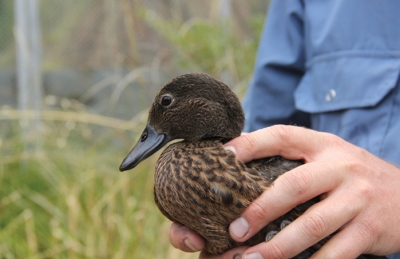Pateke numbers improving
The brown teal (pāteke) is one of three endemic teal to New Zealand and the only one to fly. Both the Auckland Island and Campbell Island teal are flightless.
Mainly nocturnal and half the size of a mallard, this shy, omnivorous duck spends time on land foraging for invertebrates, seeds, fruit, grass, and foliage. With dark brown plumage, the males are particularly distinctive from their female counterparts during breeding time in late winter.
The slightly larger males in breeding plumage obtain a green iridescence on their heads, a dark chestnut breast plus occasionally a thin white neck ring too.
Like many of our native birds, this small-necked dabbling duck has dramatically suffered from mammalian predators, loss of habitat and hunting, resulting in a plummeting population to only 700 birds in the wild by the 1990s.
Brown teal were once widespread, but thanks to brown teal species co-ordinator Kevin Evans and the Department Of Conservation brown teal recovery group, in the past 15 years, this population decline has not only been halted, but reversed, building up to about 2500 birds in the wild today.
Numbers are slowly recovering and there are several contributors to this success:
Captive breeding facilities across New Zealand that produce birds for release.
The Isaac Conservation and Wildlife Trust (ICWT), which provides facilities for flock mating for other institutions, and breeding plus pre-release conditioning and processing (banding, transmitter attachment, worming, disease screening, etc). Every captive raised bird goes to ICWT as its aviaries have stream-fed waterways for foraging, plus special feeders where the brown teal learn to obtain food. These feeders are also located at release sites.
DOC together with community groups undertake intensive predator control at release sites.
There are generally four releases of brown teal a year and the latest release of 32 birds was in August in the Abel Tasman National Park in an area managed by Janszoon.
Preparing the birds for release is an exhausting but rewarding task for all those involved at ICWT (assisted by Kevin Evans).
All release sites are vigorously assessed to ensure pāteke are released into areas with adequate protection and habitat to support self-sustaining populations.
[Ducks Unlimited was instrumental in early conservation efforts from 1975 with its ‘Operation Pateke’, New Zealand’s first large-scale co-ordinated brown teal breeding programme. – Editor]

